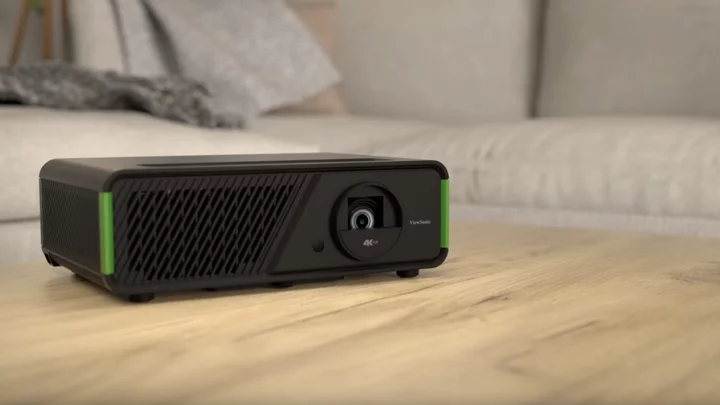While gaming projectors have been around for a long time, models like the ViewSonic X2-4K LED ($1,599.99) are something new. Much like the BenQ X3000i, our current top pick for a 4K gaming projector, the X2-4K focuses on consoles rather than PCs. ViewSonic touts it as the world's first projector designed for Microsoft Xbox Series S and X models, and it sports Microsoft's "Designed for Xbox" logo to prove the point. But don't let that stop you from considering it if you have a Sony PlayStation or other console. The X2-4K is an excellent option for big-screen gaming, with state-of-the-art short input lags and support for a 120Hz refresh rate at 1440p. And when you're not gaming, it can serve as a capable home entertainment projector for movies and video, thanks to accurate colors, good shadow detail, and support for HDR.
Design: More Green Than Blue
As with all 4K gaming projectors we've tested, the X2-4K is built around a 1,920-by-1,080-pixel DLP chip that uses TI's fast-switch pixel shifting to put 3,840 by 2,160 pixels on screen. Somewhat surprisingly, it pairs that with a four-channel red/green/blue/green LED light source. The more common LED configuration is a four-channel light source with two blue LEDs, which uses the second blue LED to boost brightness, and in some cases to improve color accuracy as well. According to ViewSonic, the second green channel in the X2-4K serves the same two purposes.
Brightness is rated at 2,000 ANSI lumens, making it reasonably bright, but not as bright as the BenQ X3000i. (ViewSonic markets the X2-4K's maximum brightness as 2,900 LED lumens, which the company says is equivalent to 2,000 ANSI lumens in this case.) On the other hand, the X2-4K's light source is rated for a 60,000-hour lifetime at full power, which is two to three times longer than the ratings for most LED light sources.
(Credit: ViewSonic)Very much on the plus side for gamers who want a portable projector, the X2-4K weighs only 7.9 pounds, a little more than half as much as the X3000i. The low weight and small size—4.8 by 13.9 by 9.9 inches (HWD)—also make it easy to handle during setup, which consists basically of pointing it at the screen, connecting power and data cables, and turning it on. The short throw lens lets you get a big image in a tight space, while the manual focus delivered a sharp image in my tests, and the manual 1.2x zoom helps match the image size to the screen easily. Connection choices include two HDMI 2.0 ports and one USB-C port.
While it's intended to connect to a gaming console, the X2-4K also has some claim to being a streaming projector, with a proprietary smart feature and app store, and a few apps pre-installed. However, these are far more limited than the streaming features in the Xbox or most other gaming consoles, so you'll find little reason to use them.
(Credit: ViewSonic)The audio system is built around two 6-watt Harmon Kardon speakers, and delivers easily good enough quality to be usable at high enough volume for a large family room. You can also connect to an external audio system using the 3.5mm audio-out port or Bluetooth, and you can use the X2-4K as a Bluetooth speaker for other audio sources.
Testing the ViewSonic X2-4K: Game On
For most home projectors, the key issue is movie and video quality. However, you wouldn't buy the X2-4K unless you wanted you to connect it to a game console, so let's start our evaluation with gaming quality instead.
The X2-4K offers a single game picture mode. If the Ultra Fast Input feature isn't on when you switch to it (which it needs to be to give the shortest lag time), you'll get a message on screen asking if you want to turn it on, and a warning that doing so will change several settings (including digital keystone and digital zoom adjustments) to their defaults—which is a good argument for avoiding those features in the first place. For my tests, I let the projector turn the fast input on. You'll find a setting in the menus that will let you turn it off or on again.
(Credit: ViewSonic)When connecting to an Xbox, the projector flashed a message suggesting that a 4K resolution setting would be the preferred choice. However, if you connect at 4K, you'll be limited to a 60Hz refresh rate and a longer input lag than you might like. One of the key features for an X2-4K connected to an Xbox is that both support a 1440p resolution at a 120Hz refresh rate, which will give you higher resolution than 1080p (for a better-looking image), and a faster refresh rate than when using 4K (for a shorter lag time). For my tests, I connected at 1440p and 120Hz.
Short lag time is another key feature. With Ultra Fast Input on, I measured lag with a Bodnar meter for 1080p/60Hz at 16.7 milliseconds (ms), and for 4K/60Hz at an essentially identical 16.8ms. For 1080p/120Hz, it dropped to 8.8ms, and at 240Hz, it was just 4.2ms. All of these results essentially are tied with a number of other gaming projectors for the shortest lag available at each refresh rate. The lag for the X2-4K's signature 1440p/120Hz was 12.6ms.
(Credit: ViewSonic)For some real-world testing, I spent some quality playing time with Diablo, using the Gaming mode's default settings. Detail was suitable for the resolution, colors—including flesh tones—were rendered well, and shadow detail held nicely in dark areas, at least to the point where I didn't feel anything was hidden in the shadows that I was supposed be able to see.
As with any gaming projector, the X2-4K can also serve as a home entertainment model for watching movies and video. The menus offer five predefined modes plus a user mode for standard dynamic range (SDR) input sources, and an identical set of choices for high dynamic range (HDR) input sources. Both sets have the same names for their modes, and only one set shows at a time, but any settings changes are saved only in the version of the mode—meaning SDR or HDR—that you're using when you make the change.
(Credit: ViewSonic)After some preliminary testing for SDR viewing, I chose the Movie mode for having the best color accuracy, though most people should find TV and Gaming modes more than acceptable as well. The only change I made was to the Light Source setting, switching it from Normal (the full power setting) to Dynamic Black 2. The change made no difference to the image in brighter scenes, but improved shadow detail in dark scenes. Image quality was on-point for the price and category, offering solid color accuracy and contrast, and handling shadow detail well in dark scenes.
For HDR viewing, I chose Gaming mode, and also used Dynamic Black 2 for the Light Source mode. Brightly lit scenes were a little darker overall than the same scenes in the SDR versions of the same movies, and colors were a little darker in terms of a hue/saturation/brightness color model, but not enough to be bothersome, or even noticeable to people who aren't as familiar with our test clips as I am. For dark scenes, the image showed even more shadow detail than for the SDR versions. You should expect this from an HDR-capable projector, but it doesn't happen with very many of them.
(Credit: ViewSonic)Although the specs list for the X2-4K doesn't include any mention of 3D at this writing, the projector does in fact support full HD 3D, using DLP-Link glasses. (ViewSonic says it plans to add that information to the product web page). I didn't see any cross talk in my tests in the one 3D mode, and 3D-related motion artifacts were less obvious than typical with current 3D projectors.
Unfortunately for those who find rainbow artifacts annoying, I saw these red/green/blue flashes fairly often. The good news is that they were fleeting enough that if you don't see them easily you might not see any. If you consider this a potential problem, however, our standard advice applies. Buy the projector from a dealer that allows easy returns without a restocking fee, so you can test it out for yourself.
(Credit: ViewSonic)Based on the Society of Motion Picture and Television Engineers (SMPTE) recommendations, the X2-4K's 2,000-ANSI-lumen rating should make it bright enough to fill a 205-inch, 1.0-gain, 16:9 screen in a dark room. Using the lower-brightness Movie mode, it was bright enough to light up my 90-inch, 1.0-gain screen nicely in a dark room and also delivered a suitably bright image using an 80-inch screen in a family room at night with ambient light. The image was also bright enough to be watchable on the 80-inch screen during the day.
Verdict: A Strong Contender, and Not Just for Xbox
If you need a projector to go with a gaming console—particularly Xbox Series S or X models, but not limited to them—the ViewSonic X2-4K is an obvious contender. The BenQ X3000i remains our top pick in this category, thanks to its good image quality, higher brightness, and more robust sound system. The BenQ also offers combined audio and video preset modes for each of three types of games: role playing, first-person shooter, and sports. But the X2-4K delivers good image quality also and has the advantage of supporting 1440p at 120Hz, for a solid compromise in the quest for both higher resolution and shorter input lag. (Note that the newly introduced BenQ X3100i also supports 1440p, and we expect to be reviewing it in the near future.)
You might want to consider less-expensive, lamp-based 4K models as well, including the BenQ TK700STi and the directly competitive Optoma UHD55. Between them, the TK700STi has the advantage of offering the same three predefined versions of game mode as the X3000i, while the UHD55 showed fewer rainbow artifacts in our tests than any of the other projectors mentioned here, which will be enough by itself for some to prefer it.
Overall, if you want the advantages of a solid-state light source (which include a longer lifetime than a lamp, slower loss of brightness, and eliminating the expense of replacement lamps), and you also want the advantage of a high refresh rate at 1440p resolution, the X2-4K is the only one that offers both.









